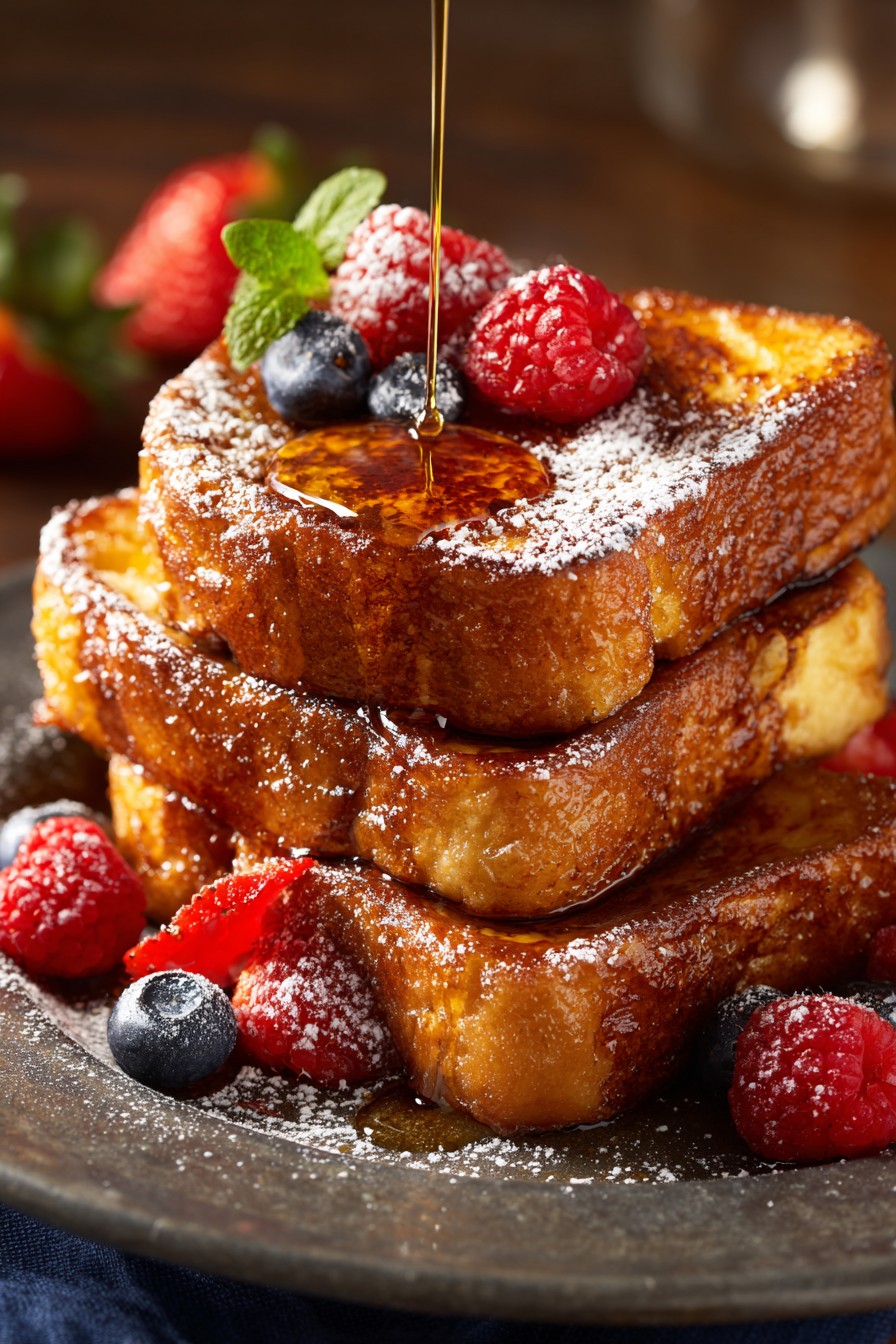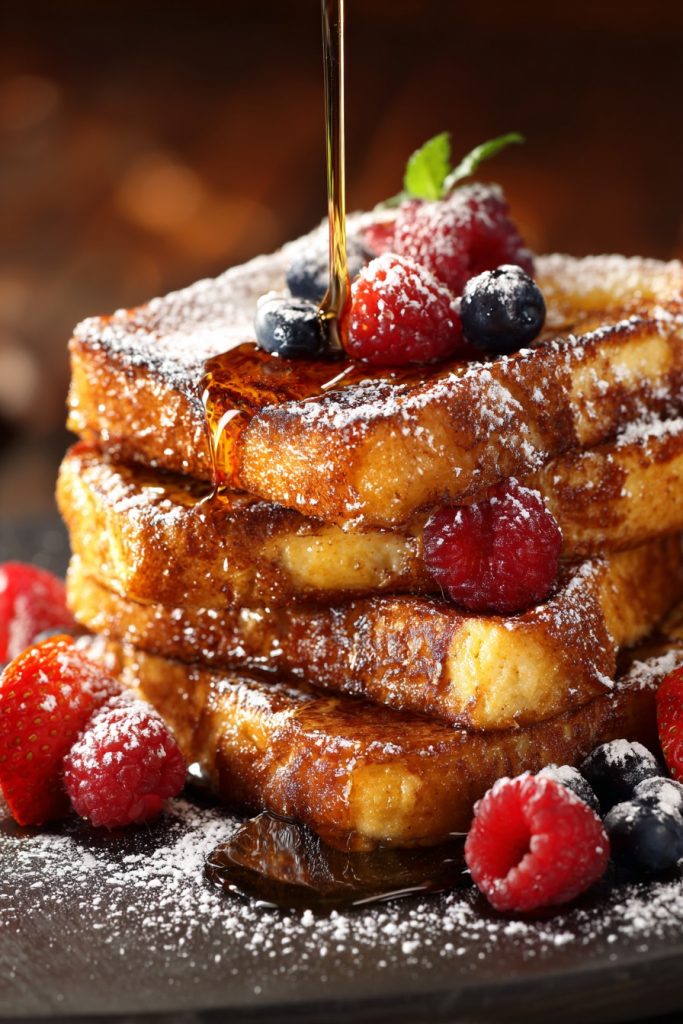Zigzagging through the spice markets of Morocco and the patisseries of Paris, I discovered that the simplest breakfasts often carry the deepest cultural memories. This cinnamon French toast recipe bridges continents, transforming humble bread into a canvas for global flavors that will transport your morning routine to distant lands where breakfast is celebrated as the day’s most important ritual.
Why This Recipe Works
- The precise cinnamon-to-sugar ratio creates a perfect balance between warm spice and sweetness, reminiscent of the aromatic blends found in Middle Eastern souks where cinnamon has been treasured for centuries as both medicine and flavor enhancer.
- Using thick-cut brioche provides a buttery, egg-rich foundation that absorbs the custard mixture without becoming soggy, similar to the texture principles used in traditional French pain perdu, where stale bread is transformed into luxurious delicacies.
- The dual-cooking method of medium heat followed by a brief high-heat finish ensures a custardy interior with a crisp, caramelized exterior, mirroring techniques used in Spanish torrijas where texture contrast is paramount to the eating experience.
- Vanilla and nutmeg additions create complex flavor layers that evoke the spice routes connecting Southeast Asia to Europe, where these ingredients traveled thousands of miles to become breakfast staples across cultures.
- Resting the soaked bread allows for complete custard absorption, a technique borrowed from Japanese cooking principles where patience in preparation yields superior texture and flavor integration in every bite.
Ingredients
- 8 slices thick-cut brioche bread (1-inch thick)
- 4 large eggs
- 1 cup whole milk
- 1/2 cup heavy cream
- 3 tablespoons granulated sugar
- 2 teaspoons ground cinnamon
- 1/2 teaspoon freshly grated nutmeg
- 2 teaspoons pure vanilla extract
- 1/4 teaspoon fine sea salt
- 4 tablespoons unsalted butter
- Maple syrup for serving
- Confectioners’ sugar for dusting
- Fresh berries for garnish
Equipment Needed
- Large mixing bowl
- Whisk
- Shallow baking dish
- Non-stick skillet or griddle
- Spatula
- Measuring cups and spoons
- Microplane or fine grater
Instructions

Prepare the Cinnamon Custard Base
Begin by cracking 4 large eggs into your large mixing bowl, whisking them vigorously until the yolks and whites become a uniform pale yellow liquid with no separation visible. Slowly stream in 1 cup of whole milk while continuing to whisk, creating a smooth emulsion that forms the foundation of your custard. Add 1/2 cup of heavy cream, which will contribute to the rich, velvety texture reminiscent of French crème anglaise. Now, incorporate 3 tablespoons of granulated sugar, 2 teaspoons of ground cinnamon that releases its warm, woody aroma as it hits the liquid, and 1/2 teaspoon of freshly grated nutmeg that provides subtle floral notes. Finally, whisk in 2 teaspoons of pure vanilla extract and 1/4 teaspoon of fine sea salt, which will enhance all the other flavors while balancing the sweetness. The mixture should be completely homogeneous with the cinnamon evenly distributed throughout, creating a fragrant liquid that promises to transform simple bread into something extraordinary. Tip: For optimal flavor development, prepare this custard base 30 minutes before cooking to allow the spices to fully hydrate and release their essential oils into the mixture.
Soak the Bread to Perfection
Arrange your 8 slices of 1-inch thick brioche bread in a single layer within your shallow baking dish, ensuring they fit comfortably without overlapping. Slowly pour the prepared cinnamon custard mixture over the bread, using a spoon to gently press down on each slice to encourage absorption while maintaining structural integrity. Allow the bread to soak for exactly 3 minutes on the first side, during which time you’ll notice the custard being drawn into the porous structure of the brioche, much like Italian panettone absorbs liqueur in traditional holiday preparations. Carefully flip each slice using a spatula and soak for an additional 2 minutes on the second side—the bread should feel heavy with liquid but still hold its shape without falling apart. The ideal saturation point is reached when the custard has penetrated completely through the bread but there’s no pooling liquid remaining in the dish. This precise timing ensures maximum flavor absorption while preventing the sogginess that can occur with over-soaking, creating the perfect foundation for golden, crisp exterior development during cooking.
Cook to Golden Brown Perfection
Preheat your non-stick skillet or griddle over medium heat for 3 minutes until a drop of water sizzles immediately upon contact, then melt 1 tablespoon of unsalted butter, swirling to coat the surface evenly. Working in batches to avoid overcrowding, carefully transfer 2-3 slices of soaked bread to the hot surface using your spatula, listening for that satisfying sizzle that indicates proper heat transfer. Cook for 4-5 minutes on the first side without moving the slices, until the bottom develops a deep golden-brown crust and the edges appear slightly caramelized. You’ll know it’s ready to flip when the surface looks dry around the edges and the bottom releases easily from the pan. Flip each slice and cook for an additional 3-4 minutes on the second side, until both sides display that beautiful mahogany coloring that indicates proper Maillard reaction development. The internal temperature should reach 160°F when tested with an instant-read thermometer, ensuring the egg custard is fully cooked while maintaining a tender, almost pudding-like interior texture.
Create the Caramelized Finish
After both sides have achieved that beautiful golden-brown coloring, increase the heat to medium-high and continue cooking each slice for 30-45 seconds per side, watching carefully as the sugar in the custard begins to caramelize and create a delicate crust. During this final stage, you’ll notice the aroma intensifying from warm spices to deeper, more complex notes reminiscent of crème brûlée’s caramelized topping. The surface should develop slight blistering and darker spotting while maintaining structural integrity—this quick high-heat finish creates textural contrast without burning the delicate spices. Use your spatula to gently press down on each slice during these final seconds, encouraging even contact with the hot surface and maximizing that crisp exterior development. Immediately transfer the finished French toast to a wire rack rather than a plate, which prevents steam from softening that carefully achieved crispness while allowing air circulation around each slice. This technique mirrors the principles used in Belgian waffle making where proper cooling maintains structural integrity between crispy exterior and tender interior.
Plate and Serve with Global Flair
Arrange two slices of your perfectly cooked cinnamon French toast on each warmed plate, creating a slight overlap for visual appeal. Dust generously with confectioners’ sugar using a fine-mesh sieve, creating a snowy landscape effect that contrasts beautifully with the golden-brown surface. Drizzle with pure maple syrup in a zigzag pattern, allowing the amber liquid to pool around the edges while some soaks into the bread’s porous structure. Scatter a handful of fresh berries around the plate—raspberries, blueberries, and sliced strawberries provide both color contrast and acidic balance to the rich, spiced bread. For those seeking authentic Parisian café presentation, add a sprig of fresh mint beside the berries, creating that touch of green that makes the entire composition sing. Serve immediately while the French toast maintains its textural contrast between crisp exterior and custardy interior, capturing that magical moment when temperature, texture, and flavor exist in perfect harmony, much like the best breakfast experiences from Copenhagen to Istanbul.
Tips and Tricks
For those seeking to elevate their French toast game beyond the basic recipe, consider these advanced techniques gathered from professional kitchens across three continents. First, the bread selection makes all the difference—while brioche works beautifully, consider seeking out challah from Jewish bakeries or panettone from Italian markets during holiday seasons. These enriched breads contain more eggs and butter in their dough, creating a sturdier structure that withstands longer soaking times while developing incredible flavor complexity. If using standard sandwich bread, look for thick-cut artisanal varieties with dense crumb structure rather than fluffy commercial types that disintegrate too easily. Second, consider infusing your custard base with additional flavor dimensions—steep the milk with orange zest and a cinnamon stick overnight in the refrigerator, then strain before using. This cold infusion technique, borrowed from French pastry chefs, extracts subtle citrus oils and spice compounds without bitterness, creating layered flavors that commercial extracts can’t replicate. Third, experiment with different cooking fats—while butter provides classic flavor, clarified butter (ghee) has a higher smoke point that prevents burning during the caramelization stage. For a dairy-free option, coconut oil introduces subtle tropical notes that complement the cinnamon beautifully, especially when paired with tropical fruit garnishes. Fourth, master the art of temperature control by using an infrared thermometer to ensure your cooking surface maintains precisely 350°F throughout the process. This scientific approach eliminates guesswork and ensures consistent results batch after batch. Finally, consider presentation techniques from luxury hotels—warm your plates in a 200°F oven for 10 minutes before serving, as hot plates maintain the French toast’s ideal temperature longer and prevent premature cooling that compromises texture. For special occasions, create a DIY topping bar with global inspirations: dulce de leche from Argentina, lemon curd from England, sesame honey from Greece, or red bean paste from Japan, transforming breakfast into an interactive culinary adventure that celebrates sweet traditions from around the world.
Recipe Variations
- Caribbean Coconut French Toast: Replace the whole milk with coconut milk and add 1/4 cup shredded coconut to the custard mixture. Use Portuguese sweet bread if available, and garnish with toasted coconut flakes, mango slices, and a drizzle of rum-infused maple syrup. The tropical flavors transport you to Jamaican breakfast tables where coconut and spice create vibrant morning celebrations.
- Mexican Chocolate French Toast: Add 2 tablespoons cocoa powder and 1/4 teaspoon cayenne pepper to the custard base, using Mexican cinnamon (canela) if available. Serve with whipped cream spiked with orange liqueur and chocolate shavings, echoing the flavors of traditional Mexican hot chocolate that combines bitter chocolate with warm spices and subtle heat.
- Asian-Inspired Matcha French Toast: Whisk 1 tablespoon matcha powder into the custard mixture, replacing cinnamon entirely. Use Japanese milk bread (shokupan) for its soft, pillowy texture, and serve with red bean paste, fresh figs, and a dusting of additional matcha powder. This variation honors Japanese tea ceremony traditions while adapting them for breakfast comfort food.
- Mediterranean Orange-Cardamom French Toast: Replace vanilla with orange blossom water and add 1/2 teaspoon ground cardamom to the custard. Use olive oil instead of butter for cooking, and garnish with pistachios, pomegranate seeds, and honey syrup. This version captures the essence of Middle Eastern mornings where floral and citrus notes dominate breakfast pastries.
- Nordic Berry French Toast: Add 1/2 cup lingonberry or cloudberry jam to the custard mixture, swirling rather than fully incorporating. Use dark rye bread for a heartier base, and serve with smoked salmon on the side for a savory-sweet combination popular in Scandinavian breakfast traditions.
Frequently Asked Questions
Can I prepare the French toast batter overnight?
Absolutely, and this technique actually enhances flavor development through extended spice hydration. Prepare your custard mixture completely—eggs, milk, cream, sugar, cinnamon, nutmeg, vanilla, and salt—then cover tightly with plastic wrap pressed directly against the surface to prevent skin formation. Refrigerate for 8-12 hours, which allows the cinnamon to fully release its oils and the vanilla to permeate throughout the liquid. When ready to cook, give the mixture a thorough whisk to recombine any separation that may have occurred. The extended resting time creates deeper, more complex flavor profiles similar to aged eggnog, though the texture may thicken slightly due to starch swelling from any residual flour in commercial cinnamon. This make-ahead approach works beautifully for holiday mornings or brunch entertaining when you want to minimize last-minute preparation stress while maximizing flavor impact.
What’s the best way to reheat leftover French toast?
For optimal texture restoration, avoid the microwave which creates steam that turns your carefully achieved crisp exterior soggy. Instead, preheat your oven to 375°F and arrange the French toast in a single layer on a wire rack set over a baking sheet. This air circulation method allows heat to reach all surfaces evenly without trapping moisture. Heat for 8-10 minutes until warmed through and the exterior regains its crispness. For individual servings, a toaster oven works beautifully using the bake function at 350°F for 5-7 minutes. If you prefer stovetop reheating, use a non-stick skillet over medium heat with a tiny amount of butter, cooking for 2-3 minutes per side until re-crisped and heated through. Properly stored in an airtight container, leftover French toast maintains quality for 2-3 days, though the texture will never quite match the fresh-from-the-pan perfection of initial preparation.
Can I make this recipe gluten-free or dairy-free?
Certainly, with careful ingredient substitutions that maintain the essential character of the dish. For gluten-free preparation, select a sturdy gluten-free bread with dense crumb structure—brioche-style GF bread works particularly well, or day-old gluten-free bagels sliced horizontally. Reduce soaking time to 90 seconds per side since GF bread tends to absorb liquid more quickly and can become mushy if over-soaked. For dairy-free adaptation, replace whole milk with unsweetened almond or oat milk and substitute coconut cream for heavy cream. Use vegan butter or coconut oil for cooking, and ensure your bread selection contains no dairy ingredients. The flavor profile will shift slightly—coconut-based substitutions complement the cinnamon beautifully while nut milks provide neutral background notes. Both adaptations allow those with dietary restrictions to enjoy this global breakfast classic while maintaining the essential textural contrast between custardy interior and crisp exterior that defines excellent French toast.
Why does my French toast sometimes taste eggy?
An overly eggy flavor typically results from incorrect custard ratios or insufficient spice balance. The ideal French toast custard should contain approximately 1 part egg to 2 parts dairy by volume—if your mixture tastes strongly of eggs before cooking, add an additional 1/4 cup milk or cream to dilute the egg flavor. Insufficient sugar can also make egg flavors more prominent, as sweetness helps mask the sulfur compounds in eggs that some palates detect strongly. Ensure you’re using fresh eggs—older eggs develop stronger flavors that become more pronounced during cooking. Finally, adequate spicing is crucial—the warm notes of cinnamon and nutmeg should dominate the flavor profile, with vanilla providing aromatic complexity that distracts from any egginess. If your French toast still tastes too eggy after these adjustments, try adding 1 tablespoon of orange juice or rum to the custard, as the acidity and alcohol help neutralize sulfur compounds while adding complementary flavor dimensions.
How can I prevent my French toast from burning?
Burnt French toast typically results from heat that’s too high, sugar content caramelizing too quickly, or insufficient fat in the pan. Maintain consistent medium heat throughout the primary cooking process, only increasing to medium-high during the final 30-45 seconds for caramelization. Use an instant-read thermometer to ensure your cooking surface stays between 325-350°F—significantly hotter than this causes the sugar in the custard to burn before the egg proteins fully set. Ensure adequate butter or oil in the pan—about 1 tablespoon per batch—and don’t overcrowd the skillet, which causes temperature drops followed by rapid reheating that encourages burning. If using particularly sugar-rich bread like brioche or challah, reduce the added sugar in your custard by 1 tablespoon to decrease caramelization speed. Finally, watch for visual cues—the surface should develop golden-brown spots gradually rather than turning dark brown quickly, and you should smell warm spices rather than acrid smoke during cooking.
Summary
This cinnamon French toast recipe transforms morning routines into global culinary journeys, balancing precise technique with cultural storytelling. From proper custard hydration to final caramelization, each step builds toward perfect textural harmony between crisp exterior and tender interior, all while celebrating the spice routes that brought cinnamon to our breakfast tables.
Cinnamon French Toast
4
servings15
minutes20
minutesIngredients
Instructions
- 1 Whisk eggs, milk, cream, sugar, cinnamon, nutmeg, vanilla, and salt in large bowl until completely smooth
- 2 Arrange bread in single layer in shallow dish, pour custard over, soak 3 minutes per side
- 3 Melt 1 tablespoon butter in skillet over medium heat, cook 2-3 slices for 4-5 minutes per side until golden brown
- 4 Increase heat to medium-high, cook 30-45 seconds per side for caramelized finish
- 5 Transfer to wire rack, repeat with remaining bread and butter
- 6 Dust with confectioners' sugar, serve with maple syrup and fresh berries



